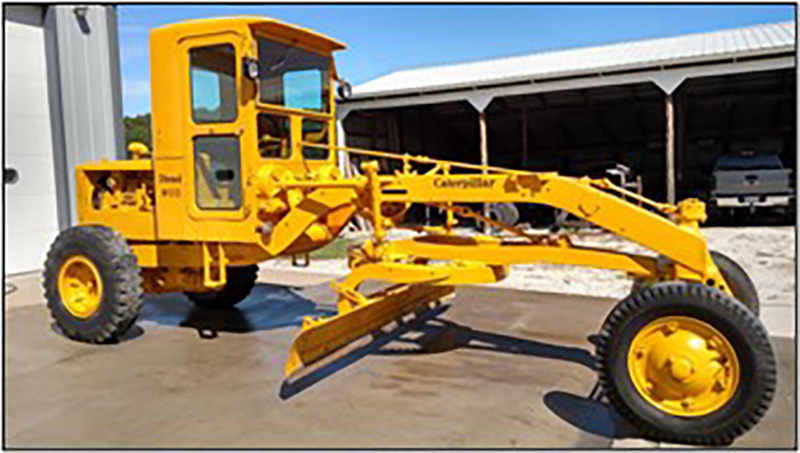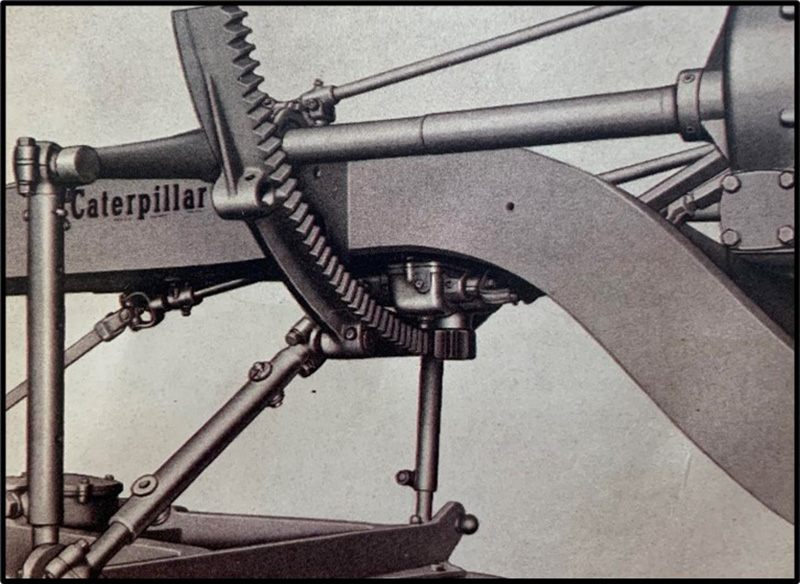1939 – 1958 Series 8M,2R,1R,1M,1U,9T,79C,95C
The No. 212 is often referred to as the baby of the motor grader family and was the replacement for the No. 10 auto patrol. The No. 212 represented the third in size of Caterpillar’s line of motor graders. Many of the features found in the larger models, however, were retained in the No. 212 which made it the most advanced machine in its class. It was offered in both gas and diesel engine options and both tandem axle and single axle drive options. The robust little unit featured a 10 ft. blade offering a full range of settings for ditching, grading, shoulder, and bank cutting up to 90 degrees. Four speed sliding gear transmission with “in-between” speeds available by use of the hand throttle. The low cost made it an ideal model for smaller governmental bodies and contractors. It still had the proper weight-to-horsepower ratio, good blade positions, a sturdy transmission with correct working speeds to utilize a full engine horsepower, and a capacity to do a full range of motor grader jobs just like its bigger brothers.


Production of the No. 212 started in 1939 as a single axle drive with the 3400G gas engine (8M). A 4 cylinder 3 ¾” bore by 5” stroke producing 32 HP. The 8M ended production with only 89 units being built from 1939-1941. In 1940 production started on the tandem axle drive axle with the same 3400G gas engine (2R). The 2R ended its production run with 63 units being built from 1940-1942. The gas versions of the No. 212 are rare in the collector world.

Pictured here is the Gas 3400G engine
In 1940 the No. 212 was also available with a diesel engine, the D3400 with a gas starting engine. A 4 cylinder 3 ¾” bore by 5” stroke producing 35 HP. It was still available in tandem and single axle options. The tandem option (1R) was produced from 1940-1943 with 1130 units produced. The single axle option (1M) was produced form 1939-1942 having 299 units built. Production on the No. 212 temporarily came to an end in 1943 due to the wartime demands, and then resumed in 1946 as a tandem axle unit (1U), this was a short-lived run with 368 units being built from 1946-1947.

Pictured here is a 1M No.212
1947 saw a new run of the No. 212 with the new updated D311 diesel engine. The 4 cylinder, 4” bore by 5” stoke D311 had a significant increase in horsepower when comparing to the D3400. The early 9T’s peaked at 45 HP, but at serial number 9T507 the HP was increased to 50 HP. From 1947-1957 (9T) there were 5220 No. 212’s built making it the largest production run of the No. 212. 1947-1954 (9T1-9T4504) shared the same serial number prefix for both tandem axle and single axle drive options, but in 1955 tandem axle drives became the only option available. The entire production run of 9T’s had a gas starting engine. A direct electric start option for the No. 212 came available in 1955 through 1957 (79C). 196 units were built with the direct electric start option. There was also an Australian built No. 212 that was the equivalent to the 9T model built in the USA. There was 166 No. 212’s built in Australia with the serial number prefix 95C.

Picture here is a 9T No.212
Late Model No.212 Specs:
Operating Weight – Single Drive 11,390 lbs/Tandem Drive 13,670 lbs
Height with cab – 9’6”
Height without cab – 7’
Length – Single Drive 21’/Tandem Drive 21’11”
Speeds @ max RPM – 1st 2.0 mph, 2nd 3.1 mph, 3rd 4.9 mph, 4th 11.9 mph, Rev 2.8 mph
| Year | 8M | 2R | 1R | 1M | 1U | 9T | 79C | 95C |
|---|---|---|---|---|---|---|---|---|
| 1939 | 8M1 - 8M16 | 1M1 - 1M66 | ||||||
| 1940 | 8M17 - 8M85 | 2R1 - 2R20 | 1R1 - 1R177 | 1M67 - 1M283 | ||||
| 1941 | 8M86 - 8M89 | 2R21 - 2R59 | 1R178 - 1R602 | 1M284 - 1M298 | ||||
| 1942 | 2R60 - 2R63 | 1R603 - 1R866 | 1M299 - 1M299 | |||||
| 1943 | 1R867 - 1R1130 | |||||||
| 1944 | ||||||||
| 1945 | ||||||||
| 1946 | 1U1 - 1U218 | |||||||
| 1947 | 1U219 - 1U368 | 9T1 - 9T110 | ||||||
| 1948 | 9T111 - 9T395 | |||||||
| 1949 | 9T396 - 9T911 | |||||||
| 1950 | 9T912 - 9T1857 | |||||||
| 1951 | 9T1858 - 9T2801 | |||||||
| 1952 | 9T2802 - 9T3625 | |||||||
| 1953 | 9T3626 - 9T4053 | |||||||
| 1954 | 9T4054 - 9T4504 | |||||||
| 1955 | 9T4505 - 9T4784 | 79C1 - 79C75 | 95C1 - 95C89 | |||||
| 1956 | 9T4785 - 9T5021 | 79C76 - 79C153 | 95C90 - 95C77 | |||||
| 1957 | 9T5022 - 9T5220 | 79C154 - 79C196 | 95C78 - 95C160 | |||||
| 1958 | 95C161 - 95C166 |
Optional equipment/attachments included: Steel Cab, Scarifier, Bulldozer, Snow Wing, Snowplow, Heater and Defroster, Engine Enclosures, Lighting, Blade Extensions, and a 12-foot blade.


The operator’s platform and controls provided operators with a comfortable place from which to work for the day. If an operator had to stand all day to see his work, he was easily fatigued and therefore less productive. Critical sight lines to the front wheels, toe of the blade and circle while seated, were made possible because the blade lift gear housings were mounted on the dash out of the operator’s vision.
The Long Radius side shift rack was the real secret in the superiority of Caterpillar Motor Graders. Not only did it give the No.212 a full range of blade movement, but it allowed you to obtain a wider range of blade positions quickly and without the having to adjust the telescopic links which increased jobsite efficiency. The rack also allowed the use of a lower mainframe out the front of the machine which made for better stability and visibility.


The members here at ACMOC have a wealth of knowledge on Caterpillar tractors and machinery. Join today and you'll find digitized original manuals, historical photos, helpful members, and a wealth of information whether you have a No. 212 or are thinking you need one like the rest of us here at ACMOC, and trust us, you do need one. The ACMOC Members Library contains Operation and Maintenance Instructions books, Parts Catalogs and Serviceman’s Reference Manuals, as well as links to YouTube videos.
Created by Nathan Duncan

